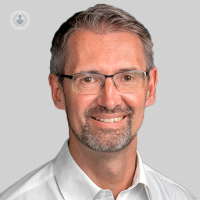Recovering from a slipped disc
Written in association with:The spine. The literal backbone of our bodies, it provides structural support as part of the skeleton, as well as hosting a large part of the central nervous system. For this reason, spinal injuries can be very serious. One more common injury is when the spinal discs that sit between the vertebrae herniate, or slip out of place. We asked leading orthopaedic surgeon Mr G. Michael Hess the important questions about slipped discs.

What causes a slipped disc?
A slipped disc usually develops on the base of long-lasting degeneration. The outer part of the disc, which is comprised of several layers of fibres (the annulus), is gradually weakened and one layer after the other is torn due to the degeneration. The inner part of the disc (the nucleus), is then pushing outside and before the last layer of the annulus is ruptured, the patients may feel a constant low back pain.
In this situation, the lifting of a heavy crate or a forward bending posture may be enough to provoke the actual disc herniation. This is usually described by the patient as a severe sciatica, which is an electric shock pain in the leg, whereas at the same time the low back pain stops.
How do you diagnose a slipped disc?
The standard examination to diagnose a slipped disc is an MRI scan of the affected part of the spine, in most cases the lumbar spine. However, a clinical exam is also necessary, especially to assess a neurological deficit like weakness or numbness in one or both extremities.
Can a slipped disc heal on its own?
Yes, indeed, a slipped disc can heal on its own. More precisely, the extruded disk fragment can be absorbed; after a couple of weeks or months the pain has subsided and it is no longer visible on another MRI scan.
When seeing the disc herniation on the initial MRI scan, it is possible to predict if this is likely to happen or not.
If there has not been any improvement over four to six months, it is very unlikely that the slipped disc will heal on its own.
Can you treat a slipped disc without surgery?
While there is still a possibility that the slipped disc will heal on its own, as described above, it is necessary to relieve the patient’s pain as well as possible. This is usually done either with pain medication and physiotherapy or more effectively with image-guided injections around the affected nerve root (transforaminal epidural injections).
These injections help to reduce the inflammation and swelling of the nerve and thus reduce the pain.
When does a slipped disc require surgery?
Every indication for surgery is done on an individual basis and after detailed discussion with the patient.
Surgery is indicated if the aforementioned injections are not effective in relieving the pain and the pain is so intense that the patient is severely limited in his daily activities. A very clear indication for an early surgery is the existence of a neurologic deficit with a functionally relevant weakness in arm or leg. In these cases an early surgery is recommended. 95% of all lumbar disc herniations requiring surgery can be operated endoscopically through a 1cm skin incision and in most cases as an outpatient procedure.
Visit Mr Hess’s Top Doctors profile to book an appointment.


